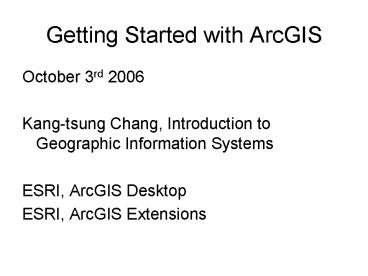Getting Started with ArcGIS - PowerPoint PPT Presentation
1 / 26
Title:
Getting Started with ArcGIS
Description:
Getting Started with ArcGIS October 3rd 2006 Kang-tsung Chang, Introduction to Geographic Information Systems ESRI, ArcGIS Desktop ESRI, ArcGIS Extensions – PowerPoint PPT presentation
Number of Views:314
Avg rating:3.0/5.0
Title: Getting Started with ArcGIS
1
Getting Started with ArcGIS
- October 3rd 2006
- Kang-tsung Chang, Introduction to Geographic
Information Systems - ESRI, ArcGIS Desktop
- ESRI, ArcGIS Extensions
2
Three Views for a GIS
- The geodatabase view
- A GIS is a spatial database containing datasets
that represent geographic information in terms of
a generic GIS data model
3
Continue
- The geovisualization view
- A GIS is a set of intelligent
- maps and other views that show features and
feature relationships on the earths surface.
4
Continue
- The geoprocessing view
- A GIS is a set of information
- transformation tools that derive new geographic
datasets from existing datasets. These
geoprocessing functions take information from
existing datasets, apply analytic functions, and
write results into newly derived datasets.
5
ArcGIS
ArcGIS provides a framework for implementing GIS
for a single user or many users on desktops, in
servers, over the Web, and in the field. ArcGIS
is an integrated collection of GIS software
products for building a complete GIS.
6
Building Blocks of ArcGIS
- ArcGIS DesktopAn integrated suite of
professional - GIS applications
- ArcGIS EngineEmbeddable developer components
- for building custom GIS applications
- Server GISArcSDE, ArcIMS, and ArcGIS Server
- Mobile GISArcPad
- ArcGIS is based on ArcObjects, a common, modular
library of shared GIS software components.
7
Desktop ArcGIS Components
- ArcMap
- ArcCatalog
- ArcToolbox
- Optional Extensions
- 3D Analyst
- Spatial Analyst
- Geostatistical Analyst
8
ArcMap
- Central application in ArcGIS Desktop for
- all map-based tasks including cartography, map
analysis, and editing.
9
I - ArcMap
- Display, create and interact with maps
10
Continue
- You can query your spatial data to find and
understand relationships among geographic
features.
11
Continue
- You can symbolize your data in a wide variety of
ways.
12
II - ArcCatalog
- Helps users organize and manage geographic
information (maps, models, metadata) - Create and Manage Files
- Define, build, export, import geodatabases
- Connect to internet services
- Record, view, and manage metadata
13
III ArcToolbox
- Data Management (import and export data)
- Data conversion (one format to another)
- Cartography
- Manage Databases
- Manipulate Vector and Raster Data
- Manage Tables
- Statistical analysis
14
IV- 3-D Analyst
- With ArcGIS 3D Analyst, users can view a surface
from multiple viewpoints, query a surface,
determine what is visible from a chosen location
on a surface, and create a realistic perspective
image by draping raster and vector data over a
surface.
15
V Spatial Analyst
- Users can create, query, map, and analyze
cell-based raster data, derive information about
their data, identify spatial relationships. - Contouring Data
- Combine Raster and Vector Data
- Raster Calculations (GRID functions)
16
VI - Geostatistical Analyst
- Provides statistical tools for analyzing and
mapping continuous data and for surface
generation. - trends,
- level of spatial autocorrelation,
- and variation among multiple datasets.
17
Help
- Most functions are documented in the online help
- Help menus are easy to use and fairly complete
- http//www.esri.com offers additional help
18
(No Transcript)
19
Vector versus Raster
- Vector Data Representation Uses X,Y
coordinates and points to represent spatial
features - Raster Data Representation uses grid (rows,
columns) to represent variations
20
Raster
- A 2-D matrix with values for each cell
- Data are divided into rows and columns
- Location is a function of the structure (i.e.
size of each cell). - Each cell has a value,
- which may be assigned
- attributes.
21
Vector
- Topological vector
- expresses spatial relationships (e.g., two lines
meeting at a point, ) - Display quickly
- Simple and compact data storage
- Difficult to find and fix errors
- Spatial queries more difficult
- Method of choice when need a
- simple map
- Example Coverage
- Nontopological
- Does not
- More complicated and less compact data storage
- Can clean up maps easily.
- Facilitates advance spatial queries.
- Can easily develop measurements
- along routes
- Method of choice when need smart map
- Example Shapefile
22
Building Topolgy Arcs
23
Building Topology - Areas
24
Attributes
- Spatial features in a GIS usually have associated
data called attributes. - Each feature may have a number of attributes
25
Joining Spatial Attribute data
- Georelational Data Model (split system)
- Spatial data stored in graphic files
- Attribute data in tables
- linked by feature IDs
- Object-oriented data model (single system)
- Both stored in a single domain
26
(No Transcript)

